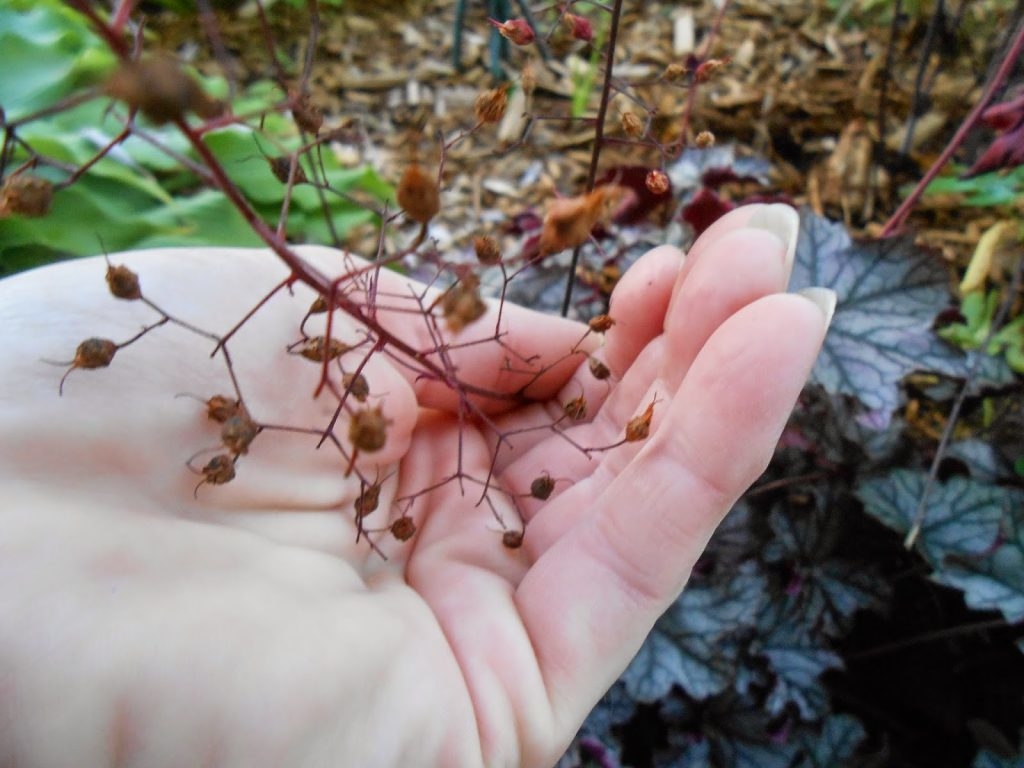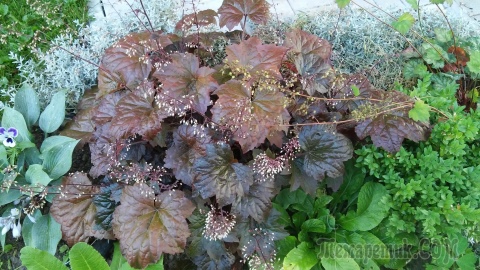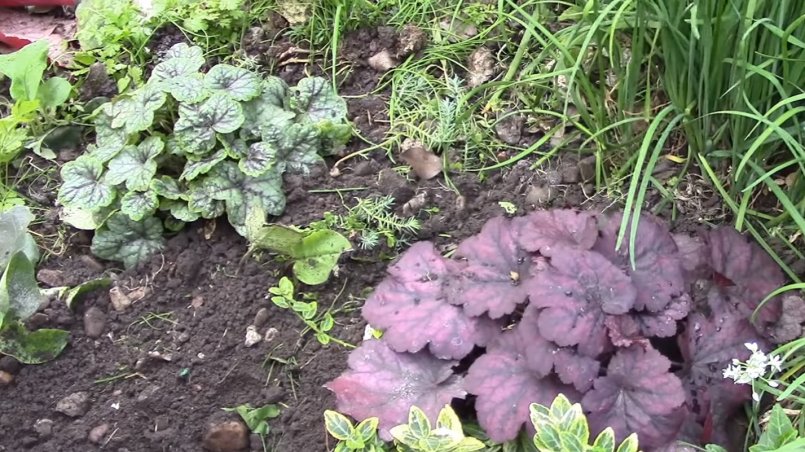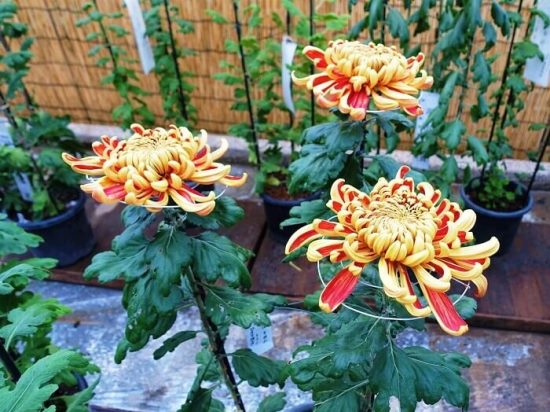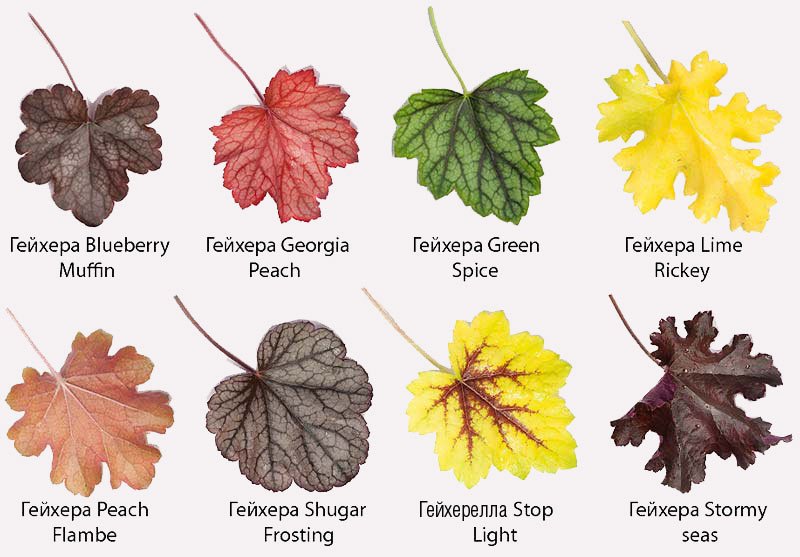Geyhera care
How to care for Heychera
Growing Heuchera is not difficult, and caring for Heuchera will not tire you. By and large, she does not need any care. In the first year of the growing season, in the year of planting, the plant does not need feeding, in subsequent years, decorative flowering varieties of Heuchera need to be fed with a universal fertilizer for flowering plants, and decorative deciduous ones - with complex fertilizers for deciduous plants, respectively.
The feeding time is before and after flowering, and the dose should be halved compared to that recommended on the package.
In the photo: Heuchera planted in the ground
Watering Heuchera should be regular, as the soil dries up - once every two days, and it is better to forget to water Heuchera than to do it twice - excess moisture harms it. But on hot dry days, you will have to water the Heuchera twice a day - early in the morning and in the evening.
You need to pour water under the bush, carefully so that the spray does not fall on the leaves, which from this can become covered with burn spots
If you do not want to have troubles with weeds and loosening the soil after watering, mulch planting Heuchera with peat in the spring.
Reproduction of heuchera
When the plant turns 3-4 years old, its rosette may fall apart and you will see a bare middle. This means that the time has come to divide the bush and plant its parts, thereby rejuvenating the Heuchera. The best time for this breeding method is May or early fall. Divide the bush in such a way that each section has 2-3 sockets.
Too long roots need to be shortened, and those on which signs of decay are found - cleaned from rot and powder the wounds with coal powder.
Parts of a divided bush are planted in pits 30x30 in size a little deeper than the mother plant was planted, at a distance of 25 cm from each other. After planting, it is advisable to water and mulch the site. Parts of the bush take root within a month. This method of reproduction of heuchera is called dividing the bush.
Planting and caring for irises: advice from experienced florists
Heuchera propagates in another vegetative way - by cuttings. Cuttings of heuchera are carried out in June or July: cuttings are cut from the mother bush as close as possible to the soil surface, but without rhizome fragments, divided into pieces of 4-6 cm, the lower sections are powdered with a root former, partially freed from the leaves and rooted in a mixture of peat and sand in makeshift greenhouses located in partial shade. Remember to ventilate the cuttings and moisten the soil in the containers. Rooting takes place in 3-4 weeks.
Heuchera pests and diseases
Heuchera get sick very rarely, and they are not afraid of pests, but sometimes they still suffer from powdery mildew, rust, gray rot and spotting. The cause of these ailments is an excess of fertilizer or stagnation of water in the roots of plants.
From powdery mildew, which covers the leaves with a whitish bloom, heuchera will be relieved by treatment with a fungicide. And spotting and rust can be defeated by spraying Heuchera twice a month with a solution of Bordeaux liquid.
In the photo: Beautiful leaves of Heuchera
Of the pests, snails, slugs, weevils, caterpillars and leaf nematodes, which can be eliminated with special insecticides, are dangerous for heuchera.
Care advice
What measures need to be taken for the successful growth and development of heuchera grown from seeds. If the flower stalks of a plant are strongly stretched in length, then they can be tied to pegs, and cut off immediately after flowering.
As for watering, it is better to carry out it after the sun goes down: this measure will prevent the burn of delicate leaves.Rainwater is best suited for watering. But it can be successfully replaced by water enriched with citric or nitric acid: the concentration of the acid must be very weak. This measure will help maintain the required level of soil acidity.
You should know that heuchera leaves are not harvested for the winter, even if they are dry. The fact is that the leafy layer on top will protect the roots of the plant from freezing. It will be possible to remove old foliage in the spring, when young foliage begins to replace it.
Before the winter cold, do not forget to cover the bushes with fallen leaves (preferably oak)
It is especially important to observe this rule for those plants that have to survive their first winter on the street.
Grown from Heuchera seeds retains its decorative qualities for 3-5 years. After that, the bush begins to go bald in the middle, which worsens the appearance of both the plant itself and the flower arrangement in which it is included. In addition, the roots, located shallow underground, by this time completely go out, giving the plant a sloppy, unkempt look. For lovers of home plants, it is worth learning more about the roots of the juniper.
To eliminate this aesthetic defect, the old plant is dug up and divided into several parts: each part with the root can be used for further vegetative propagation of the flower. The plant successfully survives this manipulation, and immediately after rooting, the parts of the heuchera quickly grow.
Brief description of cultivation
Heuchera (lat. Heuchera) is a perennial herb of the Saxifrage family, widely cultivated in many countries of the world. It owes its name to the German botanist Johann Heinrich von Heicher, who lived in the years 1677-1746 and wrote a description of this spectacular species. The native land of the plant is considered to be the mountainous regions of North America, where it is better known as the purple bell or spotted geranium and is widely used in folk medicine.
However, heuchera did not always look spectacular; even at the beginning of the 20th century, the plant was a nondescript bushes that did not stand out in anything special among other decorative greenery. The situation changed radically after the work of French specialists - the Lemoine brothers. Their work has resulted in numerous hybrids resulting from the crossing of different types of flowers.
Today, the perennial is considered one of the most spectacular and unusual plants and is able to transform even the most dull landscape beyond recognition. Any flower garden or flower bed on which heuchera is present acquires a unique charm and stands out noticeably against the background of the garden variety. Geuhera is so unpretentious that it grows even in the deserts of Arizona and California and is able to adapt to rocky soils, completely devoid of soil. Outwardly, the plant is a compact herbaceous shrub about 50 cm high.
- There is no central stem as such, but leaves with petioles 30-40 cm long have a root arrangement. Each leaf consists of 5 fused lobules.
- The plant has a taproot system, with a fleshy central root up to 50 cm long, and one bush often has several roots.
- Paniculate inflorescences consist of small flowers of red, white, pink and even green colors. Interestingly, in one variety, they may look rather ordinary-looking, while in the other they simply “burn with fire”.
- The capsule fruits contain several thousand extremely small seeds, which are much smaller in size than poppy seeds (one gram contains up to 20,000 seeds).
- Landing. In springtime, more precisely, in March – April.
- Bloom. Observed in June – August.
- Illumination. Grows well in shade or in bright, but diffused light.
- Priming. It should be moisture-absorbing, well-permeable to air and water with a pH of 5.0–6.0.
- Watering. Water the flower systematically as the soil dries out 1 time in two to three days.During a long hot dry period, you need to water the flower twice a day.
- Fertilizer. They begin to feed the Heuchera from the second year of growth, they do this before it blooms and after flowering. For this, liquid complex mineral fertilizers are used in half the dose recommended by the manufacturer.
- Reproduction. Green cuttings, dividing the bush and seed method.
- Harmful insects. Weevils, leaf nematodes, butterfly caterpillars, snails and slugs.
- Diseases. Gray rot, spotting, rust, powdery mildew.
Seed-grown Heuchera Care
A caring gardener must constantly monitor the state of the heuchera and the land in which it grows. So, you must not allow excess moisture in the soil or its drying out. The sockets that have appeared do not need to be disturbed and transplanted even in extreme cold.
Nothing will happen to them over the winter. But just in case, it is recommended to cover them with dry pine or spruce branches. An amazing feature of Heuchera is its unparalleled resistance to cold and cold weather. Even in 40 ° C frost, the plants manage to survive and grow further.
In addition, they live well in the same place for several years, without needing to change their place of residence, and are even able to grow on bare stones.
They say that this plant is designed to bring joy to the house, so growers who have made a choice in favor of Heuchera will certainly be satisfied. In order for this to happen, you should remember the main rules for caring for the planted Heuchera:
- The soil should be moderately moist.
- It is advisable to spice up the earth with minerals.
- It is necessary to protect the flower from direct sunlight.
- Do not flood the plant.
Heuchera does not tolerate moisture oversaturation. A drainage system is needed to avoid the harmful retention of water in the root system of the flower. Watering is required in moderation, but regular - about once every two days as the soil dries.
It is not recommended to spray the leaves, and even accidental ingestion during watering can lead to burns on the leaf plate. For the winter, heuchera is covered with foliage.

Growing features
Geichera is extremely popular in our time. This plant looks like a small bush with well-grown greenery. The leaf blades of this green pet are distinguished by the fact that they have a serrated edge on their cuttings. Both the shape and color of the leaves can vary. In nature, you can find a large number of varieties, for example, those that have black leaf plates, but more often they are yellow, pink, burgundy (for example, the variety "Purple Castle", popularly called "red bell") or purple.


Growing such a garden dweller usually does not cause unnecessary trouble. Any florist will be able to provide this plant with proper care, without resorting to large time and money costs.
Despite the fact that heuchera is an undemanding plant, there are a number of peculiarities associated with its cultivation.
- It is imperative to get rid of the peduncles of the plant if you are growing an ornamental-deciduous variety. If you do not follow this rule, then they begin to rapidly rise above the flower, which makes it look awkward.
- Heuchera flower stalks are allowed to be left alone and not removed only if you want to get seed in the future.
- The lower leaf blades of this flower tend to fall off over time. To avoid bare and poor-looking stems, before flowering, you need to transfer the plant as carefully as possible to another, deeper place. At the same time, the roots should not be shaken off the ground.
- When growing geykhera on your site, you must take into account what is growing with them in the neighborhood. According to experienced flower growers, the best neighbors for these plants are primrose or astilba.
- This popular plant is usually planted in the spring, in March-April.Flowering should be expected with the onset of July-August.
- It is required to grow this unpretentious flower in conditions of light shading. Bright sunlight is not dangerous for geychera, but it must be diffused.
- Fertilizing a flower is allowed only from the second year of its growth. These procedures are carried out before the plant blooms, and then at the end of this process.
- As is the case with most other plants, growing heuchera, you need to monitor their health. These flowers are susceptible to a number of diseases that must be noticed in time and treated immediately. The same applies to parasites that can cause serious harm to Heuchers.
- The bush must be earthed. Without carrying out such procedures, the plant will inevitably begin to dry out. Sometimes such actions need to be repeated a couple of times a season.
- Over time, the leaf plates of the plant become denser and darker, but at the very beginning (in the first months) they should be brighter and more transparent.

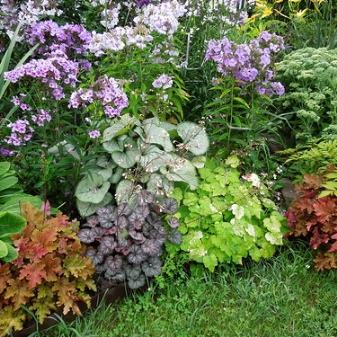
Preparing for sowing Heuchera at home
After you have decided on the timing of the procedure and waited for the optimal time to complete it, it is important to prepare all the necessary tools and equipment. Sowing this perennial, by and large, is not much different from other crops, so nothing specific needs to be done
- Heuchera seeds are very small, they germinate quite well, but they quickly lose their germination (six months after collection). It is possible to extend the germination period when stored in a metallized package in a dark, cool place (with such storage, they can remain viable for up to 1.5 years). If the seeds are fresh, then pre-sowing preparation can be dispensed with. They also do not need a stratification procedure at all.
- It is recommended to immediately prepare the sand. It is necessary for even sowing of small seeds, for this they are simply mixed with a small amount of clean, river sand.
- The soil mixture for growing Heuchera seedlings should be loose, drained, and have neutral acidity. A universal soil for flower seedlings is suitable, but it is recommended to add a small part of perlite or river sand to it. To prepare the potting mix at home, you need to mix non-acidic peat, garden soil, humus, sand, perlite (in a ratio of 2: 1: 1: 1: 0.5).
It is advisable to disinfect the soil prepared with your own hands. The most effective disinfection method is steaming (just place the soil on a cloth in a colander, hold it over the steam for 1.5 hours, stirring frequently). The second most effective method is roasting in the oven, but the method is more aggressive (put the soil in a thin layer on a baking sheet and roast for 30 minutes at + 90 ° C)
After disinfection, it is important to restore the beneficial microflora and shed the soil with a solution of a biological fungicide (for example, Fitosporin).
To plant heuchera seeds, you must choose a spacious, but not high container (plastic or wood box, plastic bowl, food container). Height about 5-6 cm
There must be drain holes at the bottom of the container.
Sowing technology and step-by-step instructions for beginners
For those who wish to preserve the varietal characteristics of the plant, it is recommended to grow seedlings, and not sow Heuchera seeds in open ground. First, you need to prepare the soil mixture by mixing the following main components:
- 1/2 part river sand;
- 2 parts of sod land;
- 1 part peat.
In the resulting soil mixture, you should also add 200 g of ash for every 5 kg of soil. You can replace this component 2-3 tbsp. l. dolomite flour. Ready-made soil is sold in a flower shop, but it is advisable to add washed sand to it in a ratio of 10: 1. Before use, it is recommended to heat the soil and sand in the oven for 5 minutes or spill it with boiling water.

Suitable containers for seedlings in all their variety
In addition to the soil mixture, you will need to prepare suitable containers.It is recommended to use plastic or wooden containers with drainage holes in the bottom. It is desirable to use expanded clay as drainage.
Step-by-step instructions for sowing Heuchera seeds for seedlings:
1. Place the soil mixture in prepared containers in such a way that at least 1.5 cm remains to the edges. If the soil has not been heat treated, then it should be poured with a solution of potassium permanganate. 
2. Remove the seeds from the packaging and treat them with a fungicide.

3. Moisten the soil with a spray gun and spread the seed over the surface. Seeds can be poured into a hollow of paper for convenience, tilt it towards the ground and pour them into the soil mixture with light taps of your fingers.

4. Sprinkle the seeds with treated sand. Layer thickness - no more than 8 mm.

5. Cover the containers with glass or a plastic bag and transfer them to a well-lit place. Moisten the soil periodically with a spray bottle.

Description of heuchera for open ground
All species of Heuchera that exist in nature are from the American continent. Here plants from the Stonefragment family, justifying their origin, settled in the rocky wastelands of the center and south of the United States and some part of Mexico. Most of the plants tamed by man are perennial decorative deciduous crops. According to the description, in the open ground, heuchera, forming a lush rosette of split finger-like leaves, changes their color depending on the season, miraculously transforming the corner of the garden allotted to it.
The decorative effect complements the flowering that lasts all summer. The brightest inflorescences on erect peduncles have blood red geykhera with small coral corollas. In other species, flowers are predominantly white or pinkish, collected in sparse paniculate inflorescences.
When to plant Heuchera outdoors? What do you need to know about the nature of the plant and its preferences?





